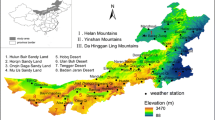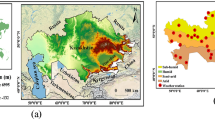Abstract
Six temperature homogeneous regions of India were chosen to calculate evapotranspiration (ET) using Hargreaves and Samani method on a monthly basis. Break Trend Analysis has been applied to the annual and seasonal ETs of the respective homogeneous regions as well as for whole India and the factors contributing for the changes in ET have been analysed. By considering the data of Reconnaissance Drought Index (RDI), Rainfall, Advanced Very High Resolution Radiometer (AVHRR) Normalized Difference Vegetation Index (NDVI) for South West (SW) monsoon (June to September) and Rice yield (major Khariff crop yield) of All India, we investigated the variations in ET during drought years. The trend analysis of seasonal and annual ET over the test regions have shown significant (levels of 0.05 to 0.01) increase over the past 107 years of the study period (1901 to 2007). The enhancement in ET is found to be 2.9 mm/decade over India and with a maximum in West Coast India (6 mm/decade), followed by Northwest India (3.9 mm/decade). The increasing trends in ET may be due to the increase in difference of maximum and minimum temperatures over these regions, which is of the order of 0.64 °C/decade on all India scale. The analysis of ET in drought years consistently shows higher values in the years when India suffered under moderate and severe droughts. It is also observed that lower rainfall values in the drought years such as 1983, 1987 and 2002 were associated with the higher ETs accompanied by lower NDVI and Rice yields. The analysis has been extended to the comparison of ET with rainfall through wavelet spectrum to understand the interannual variations which inferred the El Niño impact on ET. The correlation analysis of ET over the Interior Peninsular region with the number of days falling in active and break spells of monsoon by which drought can be characterised, revealed the significant negative and positive values, respectively.








Similar content being viewed by others
References
Al-Bakri JT, Suleiman AS (2004) NDVI response to rainfall in different ecological zones in Jordan. Int J Remote Sens 25:3897–3912
Bunker, A.F., 1965. Interaction of the summer monsoon air with the Arabian Sea, (preliminary analysis). Proc Symp Met Results International Indian Ocean Expedition, Bombay, 22–26 July 1965.
Burba GG, Verma BS (2005) Seasonal and interannual variability in evapotranspiration of native tallgrass prairie and cultivated wheat ecosystems. Agric For Meteorol 135:190–201
Burnette JD, Stahle WD (2013) Historical perspective on the dust bowl drought in the central United States. Clim Change 116:479–494
Dash SK, Jenamani RK, Kalsi SR, Panda SK (2007) Some evidence of climatic change in twentieth-century India. Clim Change 85:299–321
Gao G, Chen D, Xu Chong Y, Simelton E (2007) Trend of estimated actual evapotranspiration over China during 1960–2002. J Geophys Res 112, D11120. doi:10.1029/2006JD008010
Goyal RK (2004) Sensitivity of evapotranspiration to global warming: a case study of arid zone of Rajasthan (India). Agric Water Manage 69:1–11
Hargreaves GH, Samani ZA (1982) Estimating potential evapotranspiration. J Irrig Drain Eng ASCE 108:223–230
Jackson RD, Slater PN, Pinter PJ (1983) Discrimination of growth and water stress in wheat by various vegetation indices through clear and turbid atmosphere. Remote Sens Environ 13:187–208
Joseph PV, Raman PL (1966) Existence of low level westerly jet-stream over peninsular India during July, Indian. J Meteorol Geophys 17:407–410
Krishnan R, Sabin TP, Ayantika DC, Kitoh A, Sugi M, Murakami H, Turner A, Slingo JM, Rajendran K (2012) Will the South Asian Monsoon overturning circulation stabilize any further? Clim Dyn. doi:10.1007/s00382-012-1317-0
Kumar TV L, Barbosa H, Koteswara RK, Emily JP (2012) Some studies on the frequency of extreme weather events over India. J Agric Sci Technol 14:1343–1356
Kumar KR, Kumar KK, Pant GB (1994) Diurnal asymmetry of surface temperature trends over India. Geophys Res Lett 21:677–680
Kumar TVL, Rao KK, Barbosa H, Jothi EP (2013) Studies on spatial pattern of NDVI over India and its relationship with rainfall, air temperature, soil moisture adequacy and ENSO. Geophys J Roy Astron Soc 30:1–18
Lafreniere M, Sharp M (2013) Wavelet analysis of inter-annual variability in the runoff regimes of glacial and nival stream catchments, Bow lake, Alberta. Hydrol Process. doi:10.1002/hyp.1187
Marshall M, Funk C (2012) Examining evapotranspiration trends in Africa. Clim Dyn 38:1849–1865
Matsoukas C, Benas N, Hatzianastassiou N, Pavlakis KG, Kanakidou M, Vardavas I (2011) Potential evaporation trends over land between 1983–2008: driven by radiative or turbulent fluxes? Atmos Chem Phys Discuss 11:10935–10972
Matzneller P, Ventura F, Gaspari N, Pisa RP (2010) Analysis of climatic trends in data from the agrometeorological station of Bologna-Cadriano, Italy (1952–2007). Clim Change 100:717–731
Milesi C, Samanta A, Hashimoto H, Kumar KK, Ganguly S, Thenkabail SP, Srivastava NA, Nemani RR, Myneni BR (2010) Decadal variations in NDVI and food production in India. Remote Sens 2:758–776
Misra V, Pantina P, Chan SC, DiNapoli S (2012) A comparative study of the Indian summer monsoon hydroclimate and its variations in three reanalyses. Clim Dyn. doi:10.1007/s00382-012-1319-y
Mudiare, O.J., Gray, D.M., Mc Kay, G.A., 1986. Influence of cloud cover on evapotranspiration demand. Proc Can Hydrol Symp Canada, 1–17.
Paulo AA, Rosa RD, Pereira LS (2012) Climate trends and behaviour of drought indices based on precipitation and evapotranspiration in Portugal. Nat Hazards Earth Syst Sci 12:1481–1491
Rajeevan M, Bhate J, Kale JD, Lal B (2006) High resolution daily gridded rainfall data for the Indian region: analysis of break and active monsoon spells. Curr Sci 91(3):296–306
Rajeevan M, Gadgil S, Bhate J (2010) Active and break spells of the Indian summer monsoon. J Earth Syst Sci 119:229–247
Rajendran K, Kitoh A, Sinivasan J, Mizuta R, Krishnan R (2012) Monsoon circulation interaction with Western Ghats orography under changing climate, Projection by a 20-km mesh AGCM. Theor Appl Climatol. doi:10.1007/s00704-012-0690-2
Sarma AALN, Sivaram B (2011) Spatiotemporal distribution of weekly hydroclimatic potentialities of India — monsoon period. J Indian Geophys Union 15:9–24
Sarma AALN, Srinivas S, Karthikeya A (2005) Studies on aberrations in climate impacts — water balance model. J Indian Geophys Union 9(3):209–219
Subrahmanyam VP (1972) The concepts and the use of water balance ill ecoclimatic planning. Publ Clim Cenerton, NJ 25:46–57
Subrahmanyam, V.P., Ram Mohan, HS., 1984. Droughts and agricultural land use in India, Pakisthan. In: Climate and agricultural land use in monsoon Asia. (Ed: M.M. Yoshino), Univ. Tokyo Press, 183–202.
Teuling AJ, Hirschi M, Ohmura A, Wild M, Reichstein M, Ciais P, Buchmann N, Ammann C, Montagnani L, Richardson AD, Wohlfahrt G, Eneviratne SI (2009) A regional perspective on trends in continental evaporation. Geophys Res Lett 36, L02404. doi:10.1029/2008GL036584
Thornthwaite CW, Mather JR (1955) The water balance. Publ Clim Drexel Inst Tech 8:1
Trenberth KE, Fasullo J, Smith L (2005) Trends and variability in column integrated atmospheric water vapor. Clim Dyn 24:741–758
Tsakiris G, Vangelis H (2005) Establishing a drought index incorporating evapotranspiration. Eur Water 9(10):3–11
Uma R, Kumar TVL, Narayanan MS, Rajeevan M, Bhate J, Kumar KN (2013) Large scale features and assessment of spatial scale correspondence between IMD and TMPA gridded data sets over Indian landmass. J Earth Syst Sci 122:573–588
Verma IJ, Jadhav VN, Erande RS (2008) Recent variations and trends in potential evapotranspiration (PET) over India. Mausam 59:119–128
Von Lengerke HJ (1980) Heavy rainfall areas in Peninsular India. Arch Meteorol Geophys Bioklimatol 28:115–122
Author information
Authors and Affiliations
Corresponding author
Rights and permissions
About this article
Cite this article
Madhu, S., Kumar, T.V.L., Barbosa, H. et al. Trend analysis of evapotranspiration and its response to droughts over India. Theor Appl Climatol 121, 41–51 (2015). https://doi.org/10.1007/s00704-014-1210-3
Received:
Accepted:
Published:
Issue Date:
DOI: https://doi.org/10.1007/s00704-014-1210-3




